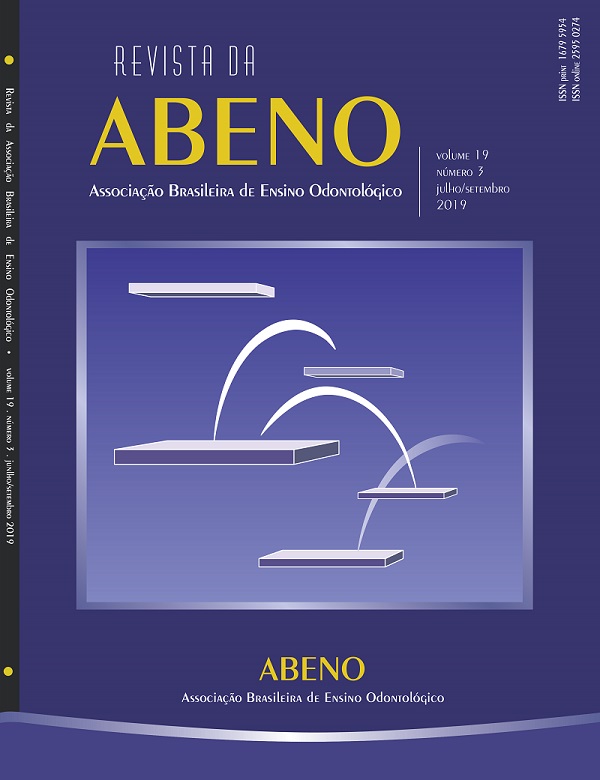How do dental faculty members relate to Evidence-Based Dentistry?
DOI:
https://doi.org/10.30979/rev.abeno.v19i3.941Palavras-chave:
Evidence-Based Dentistry. Continuing Dental Education. Dental Faculty. Dental Students.Resumo
Building the rationale to critically appraise scientific evidence on the best approach for each patient requires incorporating the Evidence-Based Dentistry (EBD) model, preferably into undergraduate dental courses. This approach would favor the diffusion of EBD culture amongst dental professionals. Therefore, this study aimed to characterize the relationship of dental faculty members with the EBD model. The study was conducted in 2018 with all 23 dental faculty members (100% response rate) of a community university. They responded the Evidence-Based Practice Questionnaire (EBPQ) and a set of supporting questions involving sociodemographics, search for information, proficiency of foreign languages, and perceived need for knowledge on issues related to EBD. The data were analyzed by descriptive statistics. A total of 73.9% of faculty members claimed having been prepared to search for scientific evidence and 69.5% are aware of connected computer systems for research. Scientific journals, the internet, courses, and colleague opinions were the main sources of information. Reading and comprehension of foreign languages was limited to 30%. The practice and attitudes towards EBD by dental faculty members were positive, with the lowest mean value of 4.85. Knowledge and skills related to EBD had lower mean values, which coincided with a relatively high perceived need for knowledge on EBD. Dental faculty members present a positive attitude towards the EBD model, have been trained to search for scientific information and acknowledge the existence of institutional structure for applying and teaching EBD. On the other hand, knowledge and skills associated with EBD may require improvement.
Downloads
Referências
Sackett DL, Rosenberg WMC, Gray JAM, Haynes RB, Richardson WS. Evidence based medicine: what it is and what it isn’t. BMJ. 1996;312(7023):71-2.
Sutherland SE. The building blocks of evidence-based dentistry. J Can Dent Assoc. 2000;66(5):241-4.
Brasil. Ministério da Saúde. Política Nacional de Gestão de Tecnologias em Saúde. 2011. 48 p.
Brignardello-Petersen R, Carrasco-Labra A, Booth HA, Glick M, Guyatt GH, Azarpazhooh A, et al. A practical approach to evidence-based dentistry: how to search for evidence to inform clinical decisions. J Am Dent Assoc. 2014;145(12):1262–7.
Conselho Nacional de Educação. Resolução CNE/CES 3. 2002.
Gillette J, Matthews JD, Frantsve-Hawley J, Weyant RJ. The benefits of Evidence-Based Dentistry for the private dental office. Dent Clin North Am. 2009;53(1):33-45.
Sabounchi SS, Nouri M, Erfani N, Houshmand B, Khoshnevisan MH. Knowledge and attitude of dental faculty members towards evidence-based dentistry in Iran. Eur J Dent Educ. 2013;17(3):127-37.
Marshall TA, Straub-Morarend CL, Qian F, Finkelstein MW. Perceptions and practices of dental school faculty regarding evidence-based dentistry. J Dent Educ. 2013;77(2):146-51.
Moreira N, Leonardi-Dutra K, Feres M, Colangelo E, Balevi B, Matthews D, et al. Impact of Evidence-Based Dentistry Workshops on educators’ use of evidence in teaching and practice: a pilot study. J Dent Educ. 2018;82(6):581-90.
Upton D, Upton P. Methodological issues in nursing research: Development of an evidence-based practice questionnaire for nurses. J Adv Nurs. 2006;54(4):454-8.
Rospendowiski K, Alexandre NMC, Cornélio ME. Adaptação cultural para o Brasil e desempenho psicométrico do “Evidence- Based Practice Questionnaire”. Acta Paul Enferm. 2014;27(5):405-11.
Schneider LR, Rodrigues Junior SA, Zanella L, Ferraz L. Prática Baseada em Evidência na Estratégia Saúde da Família: atitudes e habilidades dos cirurgiões-dentistas. Rev Eletrônica Acervo Saúde. 2018;10(6):2301-11.
Ciancio MJ, Lee MM, Krumdick ND, Lencioni C, Kanjirath PP. Self-Perceived Knowledge, Skins, Attitudes, and Use of Evidence-Based Dentistry Among Practitioners Transitioning to Dental Educators. J Dent Educ. 2017;81(3):271-7.
Brignardello-Petersen R, Carrasco-Labra A, Glick M, Guyatt GH, Azarpazhooh A. A practical approach to evidence-based dentistry: III How to appraise and use an article about therapy. J Am Dent Assoc. 2015;146(3):184-191.
Carrasco-Labra A, Brignardello-Petersen R, Azarpazhooh A, Glick M, Guyatt GH. A practical approach to evidence-based dentistry: X How to avoid being misled by clinical studies’ results in dentistry. J Am Dent Assoc. 2015;146(12):919-24.
Coleman BG, Johnson TM, Erley KJ, Topolski R, Rethman M, Lancaster DD. Preparing dental students and residents to overcome internal and external barriers to evidence-based practice. J Dent Educ. 2016;80(10):1161-9.
Kriger L, Moysés ST, Morita MC. Odontologia baseada em evidências. São Paulo: Artes Médicas; 2016.
Straub-morarend CL, Wankiiri-Hale C, Blanchette D, Lanning S, Bekhuis T, Smith B, et al. Evidence-Based practice knowledge, perceptions, and behavior: a multi-institutional, cross-sectional study of a population of U.S. dental students. J Dent Educ. 2016;80(4):430-8.
Hinton RJ, Cechow PC, Abdellatif H, Jones DL, McCann AL, Schneiderman ED, et al. Creating an Evidence-Based Dentistry culture at Baylor College of Dentistry: the winds of change. J Dent Educ. 2011;75(3):279-90.
Hinton RJ, McCann AL, Schneiderman ED, Dechow PC. The winds of change revisited: progress towards building a culture of evidence-based dentistry. J Dent Educ. 2015;79(5):499-509.
Kyriakoulis K, Patelarou A, Laliotis A, Wan AC, Matalliotakis M, Tsiou C, et al. Educational strategies for teaching evidence-based practice to undergraduate health students: systematic review. J Educ Eval Health Prof. 2016;13:34.
Kishore M, Panat SR, Aggarwal A, Agarwal N, Upadhyay N, Alok A. Evidence based dental care: Integrating clinical expertise with systematic research. J Clin Diagnostic Res. 2014;8(2):259-62.
Downloads
Publicado
Como Citar
Edição
Seção
Licença
Autores que publicam nesta revista concordam com os seguintes termos:
a) Autores mantém os direitos autorais e concedem à revista o direito de primeira publicação, com o trabalho simultaneamente licenciado sob a Licença Creative Commons Attribution que permite o compartilhamento do trabalho com reconhecimento da autoria e publicação inicial nesta revista.
b) Autores têm autorização para assumir contratos adicionais separadamente, para distribuição não-exclusiva da versão do trabalho publicada nesta revista (ex.: publicar em repositório institucional ou como capítulo de livro), com reconhecimento de autoria e publicação inicial nesta revista.
c) Autores têm permissão e são estimulados a publicar e distribuir seu trabalho online (ex.: em repositórios institucionais ou na sua página pessoal) a qualquer ponto antes ou durante o processo editorial, já que isso pode gerar alterações produtivas, bem como aumentar o impacto e a citação do trabalho publicado (Veja O Efeito do Acesso Livre).






